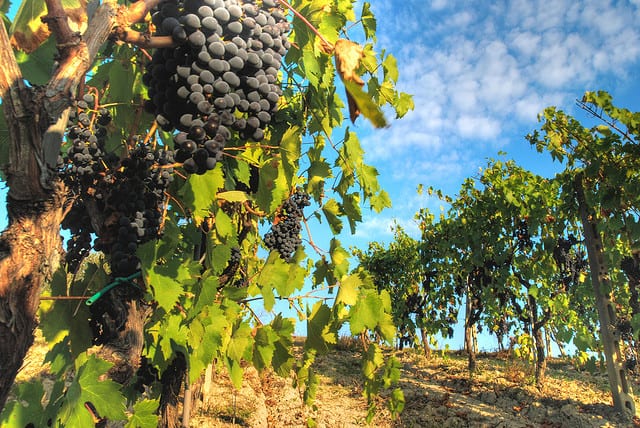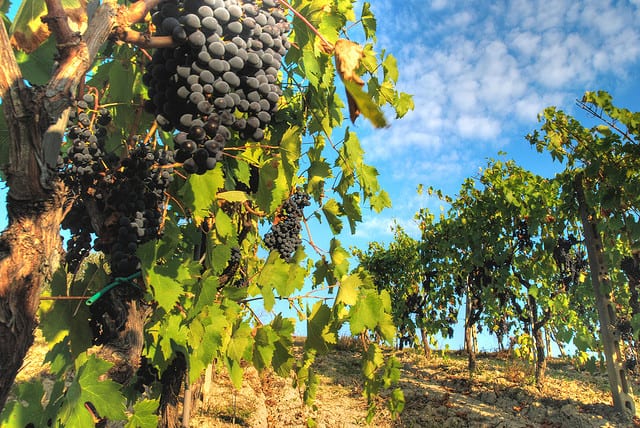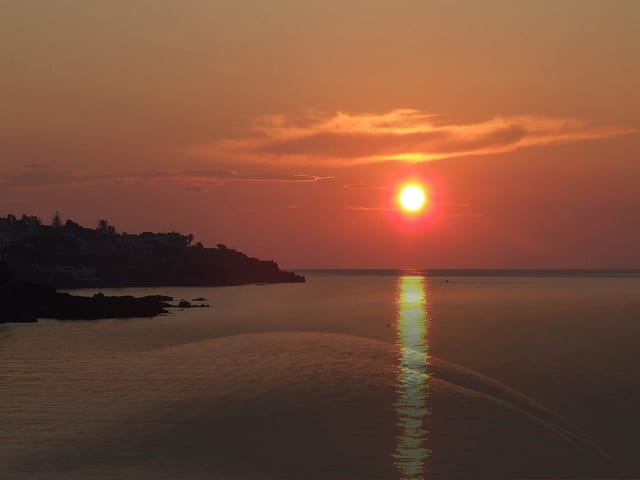
8 Reasons to Love Autumn in Italy: Fewer Crowds, Soccer Season, & More
February 17, 2023
Wondering when to Visit Italy? Though every season has its unique charms, there is something really special about autumn in Italy. The air temps begin to drop along with the crowds, the colors come out in the countryside, some of the best produce of the season hits the markets. Perhaps best of all, little towns from Puglia to Lombardia blossom with festivals. If you plan to visit Italy in the autumn a little planning will go a long way to ensure that you don’t miss some of the very seasonal pleasures that the country has to offer. Here are the 8 reasons you should visit Italy in the autumn.

Turn to the parks and countryside of Italy to see some of the best that autumn in Italy has to offer. | Photo by Gina Mussio
Table of Contents
Toggle1. Choose your temperature
In the early autumn in Italy usually enjoys fantastic weather. In fact, as far north as Venice, temperatures can often be expected to reach the 70s and 80s through September. Compare that to the sweltering heat of August and things are starting to look pretty good. Late September is usually still warm enough for a swim in the sea and even October in Italy conserves temperatures around 70 degrees Fahrenheit during the day. Around late October and into November you can start to expect more rainy days mixed in with the sunny ones, especially when visiting northern cities, like Trieste. But overall autumn in Italy has the most reliably good weather of the eyear– you can basically choose your temperature based on where you’re headed! Head to the north for cooler, more “autumnal” temperatures. The middle of Italy usually stays a few degrees warmer than its northern neighbors and the south will still be balmy as late as November, at which time it becomes pleasantly mild.
2. Head to the harvest

A vineyard in Chianti like this one is a great place to experience Italy’s harvest. | Photo by Francesco Sgroi
For hundreds of years Autumn in Italy has been a time to harvest food and celebrate those harvests – and for good reason. Fall brings an abundance of mouth-watering produce from the rich soils that have always blessed the Peninsula, especially olives and grapes. In the last decade some vineyards and olive orchards have begun to allow visitors to help with the harvest – speaking from personal experience, there is nothing quite as rewarding as picking grapes then enjoying the wine that has been produced from the same fruit in years past. It’s an authentic slice of traditional Italian culture that, if you plan right, the whole family can participate in. Not that you have to harvest the grapes to enjoy wine. If you’re headed to Tuscany or Umbria the fall is also a fantastic time to hit the vineyards for wine tastings and tours either on your own or on an organized tour.
Other foods harvested between September and November include almonds, chestnuts, white truffles, and produce like arugula, broccoli, potatoes, and zucchini. If you love eating, the fall is really one of the best times to visit Italy and try some of the different regions’ most delicious seasonal cuisine.

A Crotto is a natural cave typical of the mountainous regions in the Lombard and Swiss Alps that happen to be perfect for wine cellars! In autumn you can go to them to taste the local wines. | Photo by Gina Mussio
3. Celebrate at a local sagra
In the autumn, sagre, or festivals celebrating a local food or wine, pop up all over Italy. If you can catch one it will be the highlight of your trip. Just don’t forget to bring your appetite! In the fall, there’s a festival for every taste depending on the town. Wine, chestnuts, chocolate, truffles, porcini mushrooms, fish, polenta, and even potatoes are just a samplings of the food that have their own festivals somewhere in Italy. We adore sagre because they’re another very authentic way to experience the local produce and culture of any given area, usually with hardly any other tourists. Try chestnuts in Piacenza; mushrooms in Torino or Putignano; truffles in Gubbio, Umbria or sausage in Messina, Sicily.
To figure out which sagre and fiere are taking place across Italy during your visit, check out the sites Sagre e Ditorni and Sagre in Italia (They’re in Italian but you really only need to check dates and what the sagre is celebrating). Alternately, you can enquire with the local tourism authority of the area you’re visiting – they will have a comprehensive list of sagre happening during your stay.
If you want a more guided intro to Italian food, check out our food tours in Italy.
4. Take advantage of smaller crowds and lower prices (but not too soon)
Lower prices are one of the best things about Autumn in Italy. The diminishing crowds are not too far behind. Like cooler temperatures, lower prices begin to creep into the country at the end of August and last through the winter except for a mini-rise around Christmas. There are also fewer locals on holiday as schools start back up in mid-September and businesses that were closed for August reopen. Fall really is the budget travelers’ best friend, but timing is still very important.
But remember: Don’t jump the gun. In high-trafficked destinations like Rome, Venice, Florence, the Cinque Terre, and the Amalfi coast, high season prices run through September and even the start of October. (We go into this in more detail in our blog on why we love Rome in fall.) To take advantage of lower accommodation prices in September look to travel in more off-the-beaten-path areas like Puglia, Abruzzo, or Molise that don’t get as many foreign visitors. If you want to go to the classic places and still avoid crowds while enjoying lower prices, come as late in the season as possible – think October and early November. For more money-saving tips Check out how to get cheap flights to Italy and how to find cheap accommodation in Italy.
5. Marvel at the colors
Autumn in Italy is a sustained color explosion. Escape the cities to tour Italy’s parks and trails and enjoy the changing leaves. Try some classic Italian adventures like hiking in the Apennines in le Marche, Abruzzo or Umbria or simply driving through the countryside in Tuscany or Emilia Romagna. Italy’s deciduous trees usually show their best fall colors in October but depending on the year they could begin to change as early as September and continue into November. For those who can’t or don’t want to leave the city, head to a park such as Florence’s Boboli Gardens, Milano’s Parco Sempione, the beautiful Borghese Gardens, or the Appian Way in Rome.
If you want to experience the Appian Way with an expert local tour guide, check out our Rome as a Local tour!
6. Get caught up in calcio
Calcio is the Italian word for soccer and Italy is one of the most soccer-crazy countries in the world. The soccer season in Italy kicks off in late August and comes with the sort of fanfare that accompanies national holidays in most other countries. Attending a game or even watching one in a bar is one of the most lively cultural experiences you can have in Italy, and we recommend it to anyone, even if you aren’t a big sports fan. Games often take place during weekends and unless you are trying to attend a match featuring two rival teams, tickets can usually be purchased online pretty close to the kick off date. Keep in mind that the large stadiums are often not located in city centers so you’ll have to plan your travel to and from them accordingly. If you can’t score tickets, just pop into any pub in town on game day and you can watch in the company of some of the most passionate fans in the world.
7. Enjoy the beach
Beach-lovers don’t have to renounce a dip just because it’s autumn. In some parts of Italy, like Sicily and Puglia, the weather stays warm well into the fall, allowing passionate swimmers and sunbathers the chance to enjoy some beach time. Though most Italians in the north fold up their swimsuits after September, the beaches remain popular destinations for long walks and relaxing in the sun. In the far south, however, it’s likely to stay warm enough to swim through December. There’s even a tradition of taking a dip on Christmas day! If you’re trying to decide which beaches you’d like to visit, our blog on the best beaches in Italy can help.
8. Catch the start of ski season

Head up high enough and you can find snow even in autumn – not to mention views like this! | Photo by Gina Mussio
On the other hand, perhaps you’re simply counting down the days till winter. Luckily for you, ski season is long in the Italian Alps – usually starting the first week of December and sometimes continuing into early April! While you’ll have to head high into the mountains for natural snow in late November/early December, most resorts will have a mix of real and man-made snow. Temps will also be warmer than in the dead of winter, which is a plus unless you are searching for fresh power. Also keep in mind that Italy offers some of the cheapest skiing in the Alps. If skiing the slopes of Mont Blanc (or Monte Bianco, in Italiano) is on your bucket list, there are no better and more affordable resorts than on its Italian face.
by Gina Mussio
View more by Gina ›Book a Tour

Pristine Sistine - The Chapel at its Best
€89
1794 reviews

Premium Colosseum Tour with Roman Forum Palatine Hill
€56
850 reviews

Pasta-Making Class: Cook, Dine Drink Wine with a Local Chef
€64
121 reviews

Crypts, Bones Catacombs: Underground Tour of Rome
€69
401 reviews

VIP Doge's Palace Secret Passages Tour
€79
18 reviews

Legendary Venice: St. Mark's Basilica, Terrace Doge's Palace
€69
286 reviews











